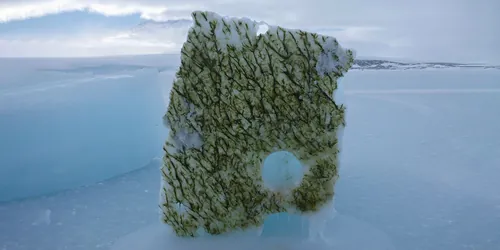
Melting Ice: A Disruption to Ocean Life as Light Spectrum Changes in Polar Waters
2025-05-23
Author: John Tan
A Shocking Transformation in Polar Seas
As our planet's ice caps continue to melt, an unexpected transformation is taking place beneath the waves—alterations in how seawater absorbs light in the polar regions. This revelation, brought to light by Monika Soja-Woźniak and her team at the University of Amsterdam, highlights a significant shift in conditions for light-harvesting organisms that thrive in these cold waters.
The Science Behind Light Absorption
In these icy seas, sunlight behaves differently. The study reveals that red wavelengths are absorbed near the surface, while deeper waters receive predominantly blue light. Yet, this is not a constant state; specific optical wavelengths prompt water molecules to vibrate, creating distinct absorption peaks. These peaks shape the ecological niches available for photosynthetic marine life.
Ice vs. Open Water: A Drastic Change in Conditions
Sea ice disrupts the usual absorption process, scattering light evenly across the spectrum. When sunlight manages to penetrate the ice, it encounters a uniform energy buffet. However, the rigid crystalline structure of ice dampens molecular vibrations, flattening the absorption peaks and homogenizing the underwater light environment.
The Impact on Marine Ecosystems
Soja-Woźniak's team theorized that these optical variations would heavily influence photosynthetic organisms. Their findings were surprising: environments with ice allowed a wider spectrum of light to penetrate, leading to the evolution of diverse photosynthetic organisms with multiple pigments. Conversely, open ocean waters favored species adapted to a blue-light niche.
A Dire Climate Implication
With the climate heating up and more ice melting, these changes threaten the entire marine food web. As the light environment shifts toward a blue-dominated spectrum, the foundational photosynthetic organisms will change too, with significant repercussions for creatures ranging from tiny plankton to massive fish and mammals. This alarming shift could ripple through entire ecosystems.
Adding Crucial Insights to Climate Models
The research, deemed invaluable for understanding climate change effects, demonstrates the stark differences in light conditions between ice-covered and open waters. This knowledge is vital for enhancing climate models, enabling scientists to predict more accurately how warming impacts polar regions.
As we witness the rapid changes in our environment, the implications of melting ice on aquatic life demand urgent attention and action for the future of our oceans.



 Brasil (PT)
Brasil (PT)
 Canada (EN)
Canada (EN)
 Chile (ES)
Chile (ES)
 Česko (CS)
Česko (CS)
 대한민국 (KO)
대한민국 (KO)
 España (ES)
España (ES)
 France (FR)
France (FR)
 Hong Kong (EN)
Hong Kong (EN)
 Italia (IT)
Italia (IT)
 日本 (JA)
日本 (JA)
 Magyarország (HU)
Magyarország (HU)
 Norge (NO)
Norge (NO)
 Polska (PL)
Polska (PL)
 Schweiz (DE)
Schweiz (DE)
 Singapore (EN)
Singapore (EN)
 Sverige (SV)
Sverige (SV)
 Suomi (FI)
Suomi (FI)
 Türkiye (TR)
Türkiye (TR)
 الإمارات العربية المتحدة (AR)
الإمارات العربية المتحدة (AR)